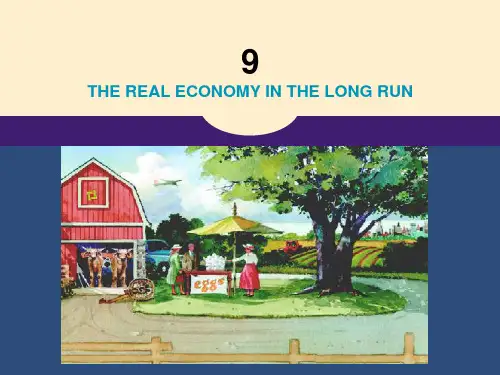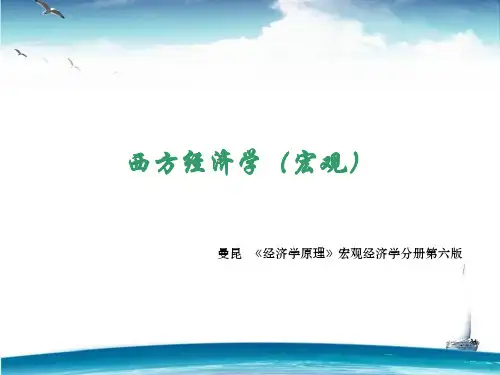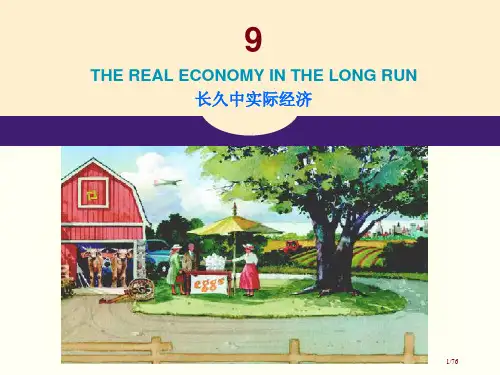曼昆《经济学原理》(宏观经济学分册)英文原版PPT课件 25
曼昆《经济学原理》(宏观经济学分册)英文原版课件——25production-growth

Production and Growth
• In the United States over the past century, average income as measured by real GDP per person has grown by about 2 percent per year.
Copyright © 2004 South-Western
Why Productivity Is So Important • Productivity refers to the amount of goods and
services that a worker can produce from each hour of work.
Copyright © 2004 South-Western
How Productivity Is Determined • The inputs used to produce goods and services
are called the factors of production. • The factors of production directly determine
Copyright © 2004 South-Western
ECONOMIC GROWTH AROUND THE WORLD
• The poorest countries have average levels of income that have not been seen in the United States for many decades.
Copyright © 2004 South-Western
Production and Growth
曼昆《经济学原理》(宏观经济学分册)英文原版PPT课件

© 2007 Thomson South-Western
Table 2 Real and Nominal GDP
© 2007 Thomson South-Western
Table 2 Real and Nominal GDP
© 2007 Thomson South-Western
Table 2 Real and Nominal GDP
© 2007 Thomson South-Western
THE ECONOMY’S INCOME AND EXPENDITURE
• When judging whether the economy is doing well or poorly, it is natural to look at the total income that everyone in the economy is earning.
Y = C + I + G + NX
© 2007 Thomson South-Western
THE COMPONENTS OF GDP
• Consumption (C):
• The spending by households on goods and services, with the exception of purchases of new housing.
© 2007 Thomson South-Western
THE MEASUREMENT OF GROSS DOMESTIC PRODUCT
• The equality of income and expenditure can be illustrated with the circular-flow diagram.
曼昆《经济学原理》宏观经济学ppt课件

研究对象
宏观经济学主要关注整个经济体系的总体运行,包 括总需求、总供给、国民收入、物价水平、就业和 经济增长等。
宏观经济学与微观经济学的关系
相互联系
宏观经济学和微观经济学是经济学的两个重要分支,它们之间相互联系、相互补充。 微观经济学是宏观经济学的基础,而宏观经济学则是微观经济学的延伸和扩展。
区别
开放经济下的政策目标
货币政策与财政政策
实现内外部经济均衡,即国内经济增长、充 分就业、物价稳定和国际收支平衡。
在开放经济下,政府可以运用货币政策和财 政政策来调节经济,但需要考虑汇率和国际 收支等因素。
汇率政策
国际经济政策协调
政府可以通过调整汇率水平来影响国际经济 活动和国内经济状况。
各国政府需要加强国际经济政策协调,共同 应对全球性经济问题,促进世界经济稳定发 展。
支持通货膨胀
凯恩斯主义宏观经济学派认为,适度的通货膨胀可以刺激 经济增长,政府可以通过控制货币供应量等手段来调节通 货膨胀率。
货币主义宏观经济学派
强调货币供应量
货币主义宏观经济学派认为,货币供应量的变化是影响经济波动 的主要因素,政府应该通过控制货币供应量来调节经济。
主张单一规则
该学派主张政府应该制定一个固定的货币增长规则,并严格执行, 以保持物价的稳定和经济的增长。
VS
政策效应互补
货币政策和财政政策在调控经济时具有不 同的特点和优势,可以相互补充、协调配 合,提高宏观调控效果。例如,在治理通 货膨胀时,可以采取紧缩性货币政策和扩 张性财政政策相配合的方式;在促进经济 增长时,可以采取扩张性货币政策和紧缩 性财政政策相配合的方式。
05
国际经济学与宏观经济政策
Chapter
【精品PPT】曼昆--《经济学原理》宏观经济学分册第六版

$12,000
$10,000 $8,000 $6,000
真实GDP(基
年是2000年)
$4,000 $2,000
名义GDP
$0 1965 1970 1975 1980 1985 1990 1995 2000 2005
34
23.4.2 GDP平减指数
• GDP平减指数是对总体价格水平的衡量 • 定义:
西方经济学(宏观)
曼昆 《经济学原理》宏观经济学分册第六版
一、什么是宏观经济学?
• 宏观经济学(macroeconomics):研究总体经济变量 的经济学。
• 宏观经济学的主要研究对象:
– 经济增长(economic growth) – 失业(unemployment) – 通货膨胀(inflation) – 国际收支与汇率(balance of payments and exchange rate)
在某一既定时期一个国家内生产的所有最终物品和劳 务的市场价值
最终物品:为终端使用者所准备 中间物品:生产其他物品的一种组成成份或要素 GDP只包括最终产品—生产过程中使用的中间物 品的价值已经包含在最终物品的价值中
一国收入的衡量
15
国内生产总值 (GDP):
在某一既定时期一个国家内生产的所有最终物品和劳 务的市场价值
微观经济学与宏观经济学之间的联系( Linkage )
微观经济学是宏观经济分析的基础( Foundation )
经济作为一个整体的行为(宏观)是以构成经济的个别单位(微观)的行 为为基础的。微观经济学关心资源配置(The allocation of resources);宏观 经济学关心资源利用(The utilization of resources)。
曼昆《经济学原理》(宏观经济学分册)英文原版PPT课件

THE COMPONENTS OF GDP • GDP includes all items produced in the economy and sold legally n markets. • What Is Not Counted in GDP?
– Every transaction has a buyer and a seller. – Every dollar of spending by some buyer is a dollar of income for some seller.
© 2007 Thomson South-Western
Y = C + I + G + NX
© 2007 Thomson South-Western
THE COMPONENTS OF GDP • Consumption (C):
• The spending by households on goods and services, with the exception of purchases of new housing. • Investment (I):
© 2007 Thomson South-Western
Table 2 Real and Nominal GDP
© 2007 Thomson South-Western
Table 2 Real and Nominal GDP
© 2007 Thomson South-Western
Table 2 Real and Nominal GDP
• “. . . Final . . .” – It records only the value of final goods, not intermediate goods (the value is counted only once).
曼昆《经济学原理第三版》宏观分册原版中英文双语Chap25省公开课一等奖全国示范课微课金奖PPT课件

15/76
Harcourt, Inc. items and derived items copyright © 2001 by Harcourt, Inc.
70规则一个例子
每年利率为7%5000美元投资在后价值翻 一番。
70/ 7 = 10
16/76
Harcourt, Inc. items and derived items copyright © 2001 by Harcourt, Inc.
22/76
Harcourt, Inc. items and derived items copyright © 2001 by Harcourt, Inc.
生产率是怎样决定
物质资本
是生产出来生产要素。
• 它是生产过程投入,也是过去生产过程产出 。
是用于生产物品与劳务设备与建筑物存 量。
• 用于生产或修理汽车工具。 • 用于生产家俱工具。 • 办公楼,学校等等…
Physical Capital
is a produced factor of production.
• It is an input into the production process that in the past was an output from the production process.
17/76
Harcourt, Inc. items and derived items copyright © 2001 by Harcourt, Inc.
Why Productivity Is So Important 为何生产率如此主要
Productivity refers to the quantity of goods and services that a worker can produce from each hour of work. 生产率是指一个工人一小时内所生产 物品与劳务量。
最新曼昆《经济学原理第三版》宏观分册原版中英文双语PPT课件Chap6PPT课件
Copyright © 2004 South-Western
Con: Policymakers should not try to stabilize the economy
• All too often policymakers can inadvertently exacerbate rather than mitigate the magnitude of economic fluctuations.
Copyright © 2004 South-Western
反对:决策者不应该努力稳定经济
• 在需要采取行动到货币政策能发挥作用之 间,货币政策对经济的作用要有一个相当 长而且不可预见的时滞。
• 许多研究表明,在作出货币政策变动的6个 月之内,这种变动对总需求的影响很小。
Copyright © 2004 South-Western
3.Should the central bank aim for zero inflation?
4.Should the government balance its budget? 5.Should the tax laws be reformed to encourage
saving?
Copyright © 2004 South-Western
Con: Policymakers should not try to stabilize the economy
• Fiscal policy works with a lag because of the long political process that governs changes in spending and taxes.
曼昆《经济学原理》(宏观经济学分册)英文原版PPT课件 25
How Productivity Is Determined • Physical capital per worker is the stock of equipment and structures that are used to produce goods and services. • Physical capital includes:
© 2007 Thomson South-Western
How Productivity Is Determined • The inputs used to produce goods and services are called the factors of production. • The factors of production include:
© 2007 Thomson South-Western
FYI: The Production Function • The preceding equation says that productivity (Y/L) depends on:
• • • • physical capital per worker (K/L), human capital per worker (H/L), and natural resources per worker (N/L), as well as the state of technology (A).
• Y/ L = A F(1, K/L, H/L, N/L) • Where:
• • • • Y/L = output per worker K/L = physical capital per worker H/L = human capital per worker N/L = natural resources per worker
曼昆《经济学原理第三》宏观分册原中英文双语Chap ppt课件
The inflation rate is the percentage change in the price level from the previous period.
通货膨胀率是从前一个时期以来物价总水平变动的百 分比。
Harcourt, Inc. items and derived items copyright © 2001 by Harcourt, Inc.
Harcourt, Inc. items and derived items copyright © 2001 by Harcourt, Inc.
The Consumer Price Index 消费物价指数
When the CPI rises, the typical family has to spend more dollars to maintain
the same standard of living. 当CPI上升时,普通家庭不得不花费 更多的美元来保持原来的生活水平。
Harcourt, Inc. items and derived items copyright © 2001 by Harcourt, Inc.
How the Consumer Price Index Is Calculated
Harcourt, Inc. items and derived items copyright © 2001 by Harcourt, Inc.
How the Consumer Price Index Is Calculated 如何计算消费物价指数
Find the Prices: Find the prices of each of the goods and services in the basket for each point in time. 找出价格:找出每个时点上篮子中每 种物品与劳务的价格。
曼昆宏观经济学原理第五版英文讲义Chapter25
Chapter Production and Growth25Economic Growth Around the World •Real GDP per person–Living standard–Vary widely from country to country •Growth rate–How rapidly real GDP per person grew in thetypical year•Because of differences in growth rates–Ranking of countries by income changessubstantially over time2TableThe variety of growth experiences1Country Period Real GDP per personat beginning of period Real GDP per personat end of periodGrowth rate(per year)Japan Brazil China Mexico Germany 1890–20061900–20061900–20061900–20061870–2006$1,4087296701,0852,045$33,1508,8807,74011,41031,8302.76%2.392.342.242.043yCanada Argentina United States IndiaUnited Kingdom Indonesia Bangladesh Pakistan 1870–20061900–20061870–20061900–20061870–20061900–20061900–20061900–20062,2242,1473,7526324,50283458369034,61015,39044,2603,80035,5803,9502,3402,5002.041.881.831.711.531.481.321.22Productivity: its Role and Determinants•Productivity–Quantity of goods and services–Produced from each unit of labor input •Why productivity is so important–Key determinant of living standards–An economy’s income is the economy’soutput4Productivity: its Role and Determinants•How productivity is determined–Physical capital•Stock of equipment and structures•Used to produce goods and services–Human capitalH it l•Knowledge and skills that workers acquirethrough education, training, and experience5Productivity: its Role and Determinants •How productivity is determined–Natural resources•Inputs into the production of goods and services•Provided by nature, such as land, rivers, andmineraldeposits–Technological knowledge•Society’s understanding of the best ways toproduce goods and services6•Population growth & Standard of living growth –is it sustainable?•Argument–Natural resources ‐will eventually limit how much world’s economies Are natural resources a limit togrowth?the world s can grow–Technological progress ‐often yields ways to avoid these limits–Improved use of natural resources–Recycling7•Are these efforts enough to permit continued economic growth?•Prices of natural resources–Scarcity ‐reflected in market pricesN t l iAre natural resources a limit togrowth?–Natural resource prices •Substantial short ‐run fluctuations•Stable or falling ‐over long spans of time–Our ability to conserve these resources•Growing more rapidly than their supplies are dwindling •Market prices ‐no reason to believe that natural resources are a limit to economic growth 8Economic Growth and Public Policy •Saving and investment•Raise future productivity–Invest more current resources in the production of capital–Trade ‐off•Devote fewer resources to produce goods and services for current consumption9Economic Growth and Public Policy •Diminishing returns and the catch ‐up effect •Higher savings rate–Fewer resources –used to make consumption goods–More resources ‐to make capital goods –Capital stock increases–Rising productivity–More rapid growth in GDP10Economic Growth and Public Policy •Diminishing returns and the catch ‐up effect •Diminishing returns–Benefit from an extra unit of an input –Declines as the quantity of the input increases•In the long run; higher savings rate –Higher level of productivity–Higher level of income–Not higher growth in productivity or income11Figure Outputper WorkerIllustrating the production function11 2. When the economy has ahigh level of capital, anextra unit of capital leads toa small increase in output.12Output per WorkerThis figure shows how the amount of capital per worker influences the amount of output per worker. Other determinants of output, including human capital, natural resources, and technology, are held constant. The curve becomes flatter as the amount of capital increases because of diminishing returns to capital 11. When the economy has a low level of capital, anextra unit of capital leads to a large increase in output.Economic Growth and Public Policy•Diminishing returns and the catch‐up effect •Catch‐up effect–Countries that start off poor–Tend to grow more rapidly than countries that start off rich•Poor countries–Low productivity–Even small amounts of capital investment •Increase workers’ productivity substantially13Economic Growth and Public Policy•Diminishing returns and the catch‐up effect •Rich countries–High productivity–Additional capital investment•Small effect on productivity•Poor countries–Tend to grow faster than rich countries14Economic Growth and Public Policy•Investment from abroad–Another way for a country to invest in newcapital–Foreign direct investment•Capital investment that is owned and operated byC it l i t t th t i d d t d ba foreign entity–Foreign portfolio investment•Investment financed with foreign money butoperated by domestic residents15Economic Growth and Public Policy•Education–Investment in human capital–Gap between wages of educated anduneducated workers–Opportunity cost: wages forgonei f–Conveys positive externality•Problem for poor countries–Brain drain16Economic Growth and Public Policy •Health and nutrition–Healthier workers –more productive–The right investments in the health of thepopulation•One way for a nation to increase productivity andO f ti t i d ti it draise living standards–Historical trends: long‐run economic growth •Improved health ‐from better nutrition•Taller workers –higher wages –betterproductivity17Economic Growth and Public Policy •Health and nutrition–Vicious circle in poor countries•Are poor–Because populations are not healthy•Populations are nothealthy–Because they are poor»Cannot afford better healthcare and nutrition18Economic Growth and Public Policy•Property rights and political stability •Foster economic growth–Protect property rights•Ability of people to exercise authority over theresources they ownth•Courts –enforce property rights–Promote political stability19Economic Growth and Public Policy •Free trade•Poorest countries–Inward‐oriented policies•Avoid interaction with the rest of the world •Outward‐oriented policies–Integrate into the world economy •International trade in goods and services –Can improve economic well‐being20Economic Growth and Public Policy •Research and development•Knowledge –public good–Farming methods–Aerospace research•Air Force; NASA–Research grants•National Science Foundation•National Institutes of Health–Tax breaks–Patent system21Economic Growth and Public Policy•Population growth•Large population–Large labor force–More consumers•Stretching natural resources?•Diluting the capital stock–High population growth•Reduces GDP per worker–Promoting technological progress22。
- 1、下载文档前请自行甄别文档内容的完整性,平台不提供额外的编辑、内容补充、找答案等附加服务。
- 2、"仅部分预览"的文档,不可在线预览部分如存在完整性等问题,可反馈申请退款(可完整预览的文档不适用该条件!)。
- 3、如文档侵犯您的权益,请联系客服反馈,我们会尽快为您处理(人工客服工作时间:9:00-18:30)。
How Productivity Is Determined
Human capital per worker is the economist’s term for the knowledge and skills that workers acquire through education, training, and experience. Like physical capital, human capital raises a nation’s ability to produce goods and services.
The factors of production directly
How Productivity Is Determined
Physical capital per worker is the stock of equipment and structures that are used to produce goods and services. Physical capital includes:
Production and Growth
Productivity refers to the amount of goods and services produced from each unit of labor input. A nation’s standard of living is determined largely by the productivity of its workers.
How Productivity Is Determined
Natural resources are inputs used in production that are provided by nature, such as land, rivers, and mineral deposits.
How Productivity Is Determined
The inputs used to produce goods and services are called the factors of production. The factors of production include:
Physical capital Human capital Natural resources Technological knowledge
Table 1 The Variety of Growth Experiences
ECONOMIC GROWTH AROUND THE WORLD
Living standards, as measured by real GDP per person, vary significantly among nations. The poorest countries have average levels of income that have s for many decades. Annual growth rates that seem small become large when compounded for many years. Compounding refers to the accumulation
Renewable resources include trees and forests. Nonrenewable resources include petroleum and coal.
Natural resources can be important but are not necessary for an economy to be highly productive in producing goods and
Tools used to build or repair automobiles. Tools used to build furniture. Office buildings, schools, etc.
Physical capital is a produced factor of production.
© 2007 Thomson South-Western
Production and Growth
A country’s standard of living depends on its ability to produce goods and services. Within a country there are large changes in the standard of living over time. In the United States over the past century, average income as measured by real GDP per person has grown by about 2 percent per year.
Productivity: Its Role and Determinants
Why Productivity Is So Important
Productivity plays a key role in determining living standards for all nations in the world. To understand the large differences in living standards across countries, we must focus on the production of goods and services.
